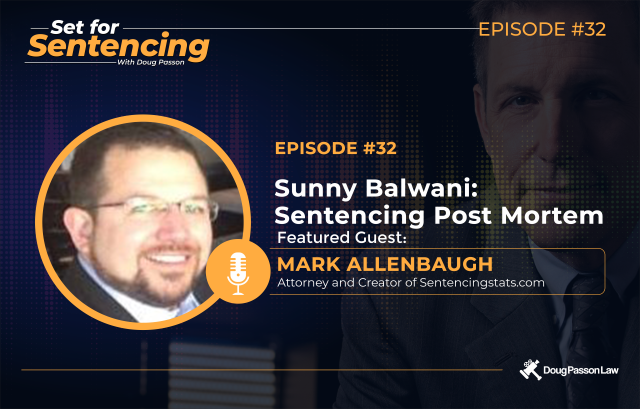Sunny Balwani (Elizabeth Holmes co-defendant) Sentencing Post-Mortem: The “ABCs” of Federal Fraud Sentencing

Watch this episode on YOUTUBE, on APPLE PODCASTS, or wherever you get your podcasts!
In this case, we deal with the “ABCs” of federal fraud sentencing, meaning, we’re doing a deep comparative analysis of three recent high profile cases: MICHAEL AVENATTI, SUNNY BALWANI, and JULIE & TODD CHRISLEY.
I never ceased to be amazed by the miraculous work Mark Allenbaugh does with sentencing stats, but, maybe more so than any of our previous collaborations, this one is chock full of so much practical advice for every lawyer and litigant facing sentencing. Besides the comparative overview we do a deeper dive into Balwani’s sentencing proceeding, and Doug digs in to the sentencing memoranda here to grade the performance of the government and defense lawyers in presenting their written narrative to the court.
The main takeaway from the statistics, is that when it comes to how the guidelines are applied, the only thing that seems certain is uncertainty. The real lesson here, therefore, is that telling a compelling a sentencing story is far more important than the seemingly random and irrational, dehumanizing sentencing guidelines. In other words, a client gets far more traction using 18 USC 3553 to build their powerful and persuasive sentencing narrative.
IN THIS EPISODE:
- Statistical comparative analysis of Sunny Balwani, Michael Avenatti, Julie & Todd Chrisley, and Elizabeth Holmes sentencing outcomes;
- Whether judges artificially manipulate the guidelines to reach a result they feel is right;
- Proposing fixes to the very broken sentencing guidelines (spoiler alert: it’s the sentencing TABLE that’s the real problem);
- Story matters, perhaps most of all and likely explains much of these disparate outcomes;
- A scathing critique of the government’s sentencing memo in Balwani;
- Kudos to the defense for drafting a much more compelling piece of narrative writing;
- Applying the “AND, BUT, THEREFORE” (problem-solution dynamic) narrative model to the defense memo;
- Stats on disparate treatment of men vs. (white, educated) women at sentencing;
- Stats on disparate treatment based on race;
- Could Balwani’s case have beneffited from a sentencing video?
- Disabusing lawyers from going the old school route of character letter inundation;
- What’s the right length for a sentencing memo;
- Why defense lawyers must still always discuss Covid, life expectancy, BOP health care, and overcrowding;
- How lawyers can take themselves out of the sentencing conversation by making an unsupported, outlandish, unreasonable sentencing recommendations;
- The one aspect of the government’s argument that rubbed Doug really wrong;
- Some specifics about where Mr. Balwani may serve his sentence.
LINKS:
Elizabeth Holmes Sentencing Post-Mortem Podcast Episode: https://setforsentencing.com/podcast/elizabeth-holmes-sentencing-post-mortem/
ABT Book! When analyzing the defense memo, we see the ABT at work, clearly defining the problem the judge needs to address (“the But”). The book is 7 bucks on amazon if you want to learn more. If you’re not up for buying the book, here’s a short blog post on it: https://setforsentencing.com/blog/the-three-most-important-words-in-persuasive-communication/
Patterson study: we can’t stress this enough. Unless the crime is beyond atrocious, most judges will think long and hard before imposing a sentencing they believe will result in a defacto life sentence. Therefore, life expectancy could make a huge impact at sentencing. But do it right, using this study showing that life expectancy for incarcerated individuals is far different: https://ajph.aphapublications.org/doi/full/10.2105/AJPH.2012.301148?role=tab
Where a person will serve their sentence and how they will serve it can be mitigation. Sometimes an expert on this topic is necessary. Check out Episode 3, “Telling the Stry of Prison at Sentencing” with BOP Expert, Former Warden Maureen Baird. https://setforsentencing.com/podcast/telling-the-story-of-prison-at-sentencing/
Mitigation Videos : Could Sunny Balwani have benefitted from a defense documentary or “sentencing mitigation video”? There is a debate about whether this could be counterproductive in high-dollar white collar cases. In this case, however, Passon makes a compelling case that the truth of Mr. Balwani’s good character could have come to life in living color with a well-made defense doc. If you’re interested in seeing some examples, visit www.setforsentencing.com
MARK’s BIG BEAUTIFUL CHARTS: Mark Allenbaugh (www.sentencingstats.com), as always, came ready with some fantastic visual aids to help us better understand the comparative sentencing outcomes. If you want to see them, you can either visit the full shownotes page at: www.setforsentencing/balwani or check out the video version of the podcast on our YouTube channel: https://www.youtube.com/channel/UCjUA_CTn7Kg3xU21r6zAjvw









Sharing is caring!



